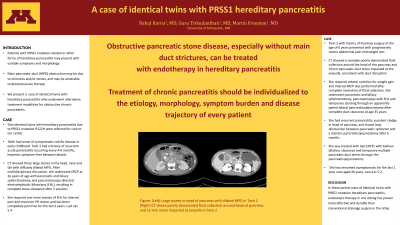Monday Poster Session
Category: Biliary/Pancreas
P1793 - A Case of Identical Twins With PRSS1 Hereditary Pancreatitis
Monday, October 28, 2024
10:30 AM - 4:00 PM ET
Location: Exhibit Hall E

Has Audio
- RK
Rahul Karna, MD
University of Minnesota Medical Center
Minneapolis, MN
Presenting Author(s)
Rahul Karna, MD1, Guru Trikudanathan, MD2, Martin Freeman, MD1
1University of Minnesota Medical Center, Minneapolis, MN; 2University of Minnesota, Minneapolis, MN
Introduction: Patients with hereditary pancreatitis may present with variable symptoms and morphology. Main pancreatic duct (MPD) obstruction may be due to strictures and/or stones and may be amenable to decompressive therapy. We present a case of identical twins with hereditary pancreatitis who underwent alternative treatment modalities for obstructive chronic pancreatitis.
Case Description/Methods: Two identical twins with hereditary pancreatitis due to PRSS1 mutation-R122H were referred for care at age 17. Both had onset of symptomatic calcific disease in early childhood. Twin 1 had a history of recurrent acute pancreatitis occurring every 4-6 months, however, symptom-free between attacks. CT showed three large stones in the head, neck and tail with diffusely dilated MPD. After multidisciplinary discussion, she underwent ERCP with pancreatic and biliary sphincterotomy, and pancreatoscopy directed electrohydraulic lithotripsy (EHL), resulting in complete stone clearance after 2 sessions. She required one more session of EHL for interval pain and recurrent PD stones and has been completely pain free for the last 6 years. Twin 2 had undergone Puestow surgery at the age of 6 years. She presented with progressively severe abdominal pain and weight loss. CT showed a complex poorly demarcated fluid collection around the head of the pancreas and 15mm pancreatic duct stone impacted at the ampulla, consistent with duct disruption. Interval ERCP was performed after complete resolution of fluid collection. She underwent pancreatic and biliary sphincterotomy, pancreatoscopy with EHL and temporary stenting through an apparently patent lateral pancreaticojejunostomy after complete duct clearance. She had recurrent pancreatitis and purulent sludge in head of pancreas. She required two more two ERCPs with balloon dilation, clearance and temporary multiple pancreatic duct stents through the pancreaticojejunostomy. She has remained asymptomatic for the last three months.
Discussion: Obstructive pancreatic stone disease, especially without main duct strictures, can be treated with endotherapy in hereditary pancreatitis. In these paired cases of identical twins with PRSS1 mutation hereditary pancreatitis, endoscopic therapy in one sibling has proven more effective and durable than conventional drainage surgery in the other. Treatment of chronic pancreatitis should be individualized to the etiology, morphology, symptom burden and disease trajectory of every patient.
Disclosures:
Rahul Karna, MD1, Guru Trikudanathan, MD2, Martin Freeman, MD1. P1793 - A Case of Identical Twins With PRSS1 Hereditary Pancreatitis, ACG 2024 Annual Scientific Meeting Abstracts. Philadelphia, PA: American College of Gastroenterology.
1University of Minnesota Medical Center, Minneapolis, MN; 2University of Minnesota, Minneapolis, MN
Introduction: Patients with hereditary pancreatitis may present with variable symptoms and morphology. Main pancreatic duct (MPD) obstruction may be due to strictures and/or stones and may be amenable to decompressive therapy. We present a case of identical twins with hereditary pancreatitis who underwent alternative treatment modalities for obstructive chronic pancreatitis.
Case Description/Methods: Two identical twins with hereditary pancreatitis due to PRSS1 mutation-R122H were referred for care at age 17. Both had onset of symptomatic calcific disease in early childhood. Twin 1 had a history of recurrent acute pancreatitis occurring every 4-6 months, however, symptom-free between attacks. CT showed three large stones in the head, neck and tail with diffusely dilated MPD. After multidisciplinary discussion, she underwent ERCP with pancreatic and biliary sphincterotomy, and pancreatoscopy directed electrohydraulic lithotripsy (EHL), resulting in complete stone clearance after 2 sessions. She required one more session of EHL for interval pain and recurrent PD stones and has been completely pain free for the last 6 years. Twin 2 had undergone Puestow surgery at the age of 6 years. She presented with progressively severe abdominal pain and weight loss. CT showed a complex poorly demarcated fluid collection around the head of the pancreas and 15mm pancreatic duct stone impacted at the ampulla, consistent with duct disruption. Interval ERCP was performed after complete resolution of fluid collection. She underwent pancreatic and biliary sphincterotomy, pancreatoscopy with EHL and temporary stenting through an apparently patent lateral pancreaticojejunostomy after complete duct clearance. She had recurrent pancreatitis and purulent sludge in head of pancreas. She required two more two ERCPs with balloon dilation, clearance and temporary multiple pancreatic duct stents through the pancreaticojejunostomy. She has remained asymptomatic for the last three months.
Discussion: Obstructive pancreatic stone disease, especially without main duct strictures, can be treated with endotherapy in hereditary pancreatitis. In these paired cases of identical twins with PRSS1 mutation hereditary pancreatitis, endoscopic therapy in one sibling has proven more effective and durable than conventional drainage surgery in the other. Treatment of chronic pancreatitis should be individualized to the etiology, morphology, symptom burden and disease trajectory of every patient.
Disclosures:
Rahul Karna indicated no relevant financial relationships.
Guru Trikudanathan: AbbVie – Grant/Research Support. Boston Scientific – Consultant.
Martin Freeman indicated no relevant financial relationships.
Rahul Karna, MD1, Guru Trikudanathan, MD2, Martin Freeman, MD1. P1793 - A Case of Identical Twins With PRSS1 Hereditary Pancreatitis, ACG 2024 Annual Scientific Meeting Abstracts. Philadelphia, PA: American College of Gastroenterology.
